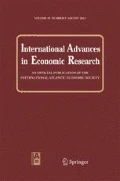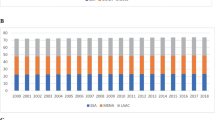Abstract
This paper uses a stochastic translog production frontier to estimate technical inefficiency indices whose conditional mean is specified as a function of FDI and its interaction with openness of the economy. The model is estimated using an annual panel of 46 countries for the years, 1981–2001. The results suggest that increased FDI increases potential output in both developed and developing countries with the effect being more profound in the former. It is also found that increased FDI reduces technical inefficiencies the more open is the economy but that this effect holds only for developed economies. Thus qualified support is found for the “Bhagwati hypothesis” as the results reveal that the efficiency–enhancing effect of FDI depends not only on openness but also on the degree of development of the host country.
Similar content being viewed by others
Notes
For more on different specifications of the panel stochastic production frontier model see Coelli et al. (1998, pp. 202–204).
In addition to the direct effect of technology transfer associated with FDI, Damijan et al. (2003) also point to spillover effects through intra-industry or “horizontal” and inter-industry or “vertical” channels.
The developing countries in the sample consists of Algeria, Argentina, Bangladesh, Brazil, Chile, China, Colombia, Costa Rica, Dominican Republic, Ecuador, Guatemala, Honduras, India, Indonesia, Kenya, Malaysia, Mexico, Morocco, Pakistan, Panama, Paraguay, Peru, Philippines, Sierra Leone, Swaziland, Thailand, Venezuela, and Zambia. The developed countries are Australia, Austria, Belgium, Canada, Denmark, Finland, France, Greece, Ireland, Italy, Japan, Netherlands, New Zealand, Portugal, Spain, Sweden, United Kingdom, and United States. All data are from the United Nations World Development Indicators.
We use the FRONTIER software, version 4.1 by Coelli (1996) to estimate the translog production function and technical inefficiencies.
Given that these two variables are measured in percentages, we do not express them in the logarithmic form.
Note, however, that for the developed countries the sum of the positive coefficient on FDI (0.192) and that of the interaction between FDI and openness (-0.001) is still positive pointing to increased inefficiency in these economies from FDI inflow.
References
Aigner, D. J., Lovell, C. A. K., & Schmidt, P. (1977). Formulation and estimation of stochastic frontier production function models. Journal of Econometrics, 6, 21–37.
Aitken, B., & Harrison, A. E. (1989). Do domestic firms benefit from foreign investment? Evidence from Venezuela. American Economic Review, 89(3), 605–618.
Balasubramanyam, V. M., Salisu, M., & Sapsford, D. (1996). Foreign direct investment and growth in EP and IS countries. Economic Journal, 106, 92–105.
Battese, G. E., & Coelli, T. J. (1988). Prediction of firm-level technical efficiencies with a generalized frontier production function and panel data. Journal of Econometrics, 38, 387–399.
Battese, G. E., & Coelli, T. J. (1995). A model for technical inefficiency effects in a stochastic production frontier for panel data. Empirical Economics, 20(2), 325–332.
Bengoa, M., & Sanchez-Robles, B. (2003). Foreign direct investment, economic freedom, and growth: New evidence from Latin America. European Journal of Political Economy, 19(3), 529–545.
Bhagwati, J. N. (1978). Anatomy and Consequences of Exchange Control Regimes. Studies in International Economic Relations. New York: NBER.
Blomstrom, M., Zejan, M., & Lipsey, R. E. (1992). What explains developing country growth? National Bureau of Economic Research Working Paper: 4132.
Blonigen, B. A. (2005). A review of the empirical literature on FDI determinants. Atlantic Economic Journal, 33(4), 383–403.
Borensztein, E., De Gregorio, J., & Lee, J. (1995). How does foreign direct investment affect economic growth?” National Bureau of Economic Research, Working Paper: 5057.
Chowdhury, A. R., & Mavrotas, G. (2006). FDI and growth: What causes what? The World Economy, 29(1), 9–19.
Ciruelos, A., & Wang, M. (2005). International technology diffusion: Effects of trade and FDI. Atlantic Economic Journal, 33(4), 437–449.
Coelli, T. J. (1996). A guide to FRONTIER Version 4.1: A computer program for stochastic production and cost function estimation. Centre for efficiency and productivity analysis, University of New England, Armidale, NSW, Australia, Working paper: 96/07.
Coelli, T. J., Rao, D. S. P., & Battese, G. E. (1998). An introduction to efficiency and productivity analysis. Boston: Kluwer Academic Publishers.
Damijan, J. P. Knell, M., Majcen, B., & Rojec, M. (2003). Technology transfer through FDI in Top-10 transition countries: How important are direct effects, horizontal and vertical spillovers? The University of Michigan Business School, William Davidson Working Paper: 549.
Dollar, D. (1992). Outward-oriented developing economies really do grow more rapidly: Evidence from 95 LDCs, 1976–1985. Economic Development and Cultural Change, 40(3), 523–544.
Frimpong, J. M., & Oteng-Abayie, E. F. (2006). Bivariate causality analysis between FDI inflows and economic growth in Ghana.” Munich University, MPRA Paper No. 351.
Kohpaiboon, A. (2002). Foreign trade regime and FDI-growth nexus: A case study of Thailand. Department of Economics, Australian National University, Working Papers.
Lipsey, R. E. (2000). Inward FDI and economic growth in developing countries. Transitional Corporations, 9(1), 61–95.
Lipsey, R. E. (2002). Home and host country effects of FDI. National Bureau of Economic Research Working Papers: 9293.
Meeusen, W., & van den Broeck, J. (1977). Efficiency estimation from Cobb-Douglas production functions with composed error. International Economic Review, 18(2), 435–444.
Pitt, M. M., & Lee, L. (1981). Measurement and sources of technical Inefficiency in the Indonesian weaving industry. Journal of Development Economics, 9, 43–64.
Romer, D. (1993). Openness and inflation: Theory and evidence. Quarterly Journal of Economics, 108(4), 869–903.
Schumpeter, J. (1912). Theorie der Wirtschaftlichen Entwicklug (The Theory of Economic Development,) 1934 translated edition. Cambridge, Massachusetts: Harvard University Press.
Author information
Authors and Affiliations
Corresponding author
Additional information
This research was partially funded through a grant from Marquette University College of Business Administration Miles fund and a grant for the Institute for Global Economic Affairs.
Rights and permissions
About this article
Cite this article
Nourzad, F. Openness and the Efficiency of FDI: A Panel Stochastic Production Frontier Study. Int Adv Econ Res 14, 25–35 (2008). https://doi.org/10.1007/s11294-007-9128-5
Received:
Published:
Issue Date:
DOI: https://doi.org/10.1007/s11294-007-9128-5




